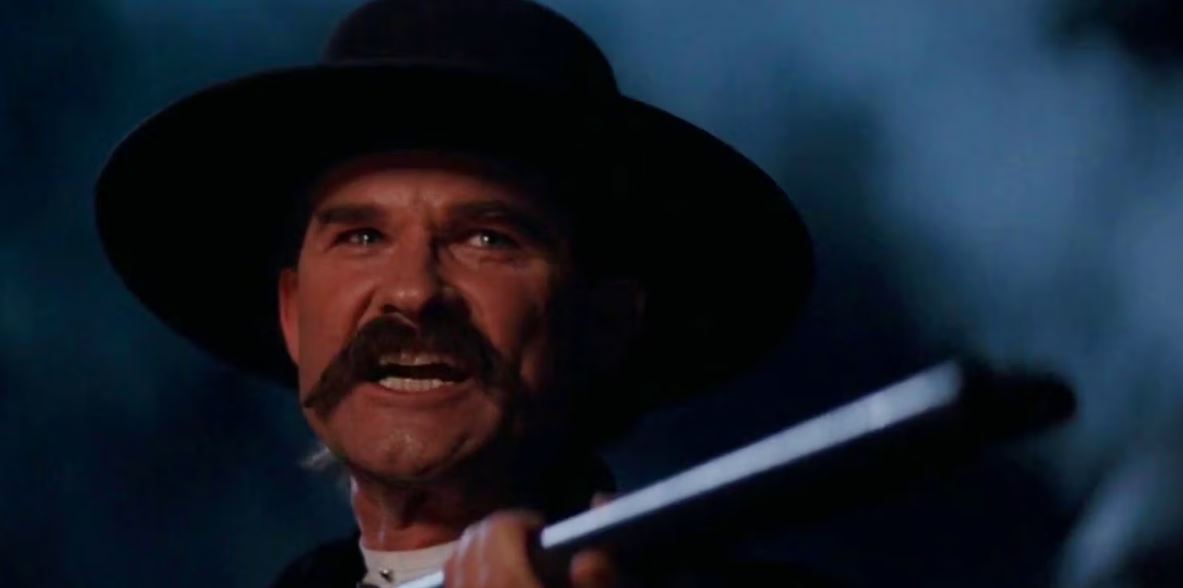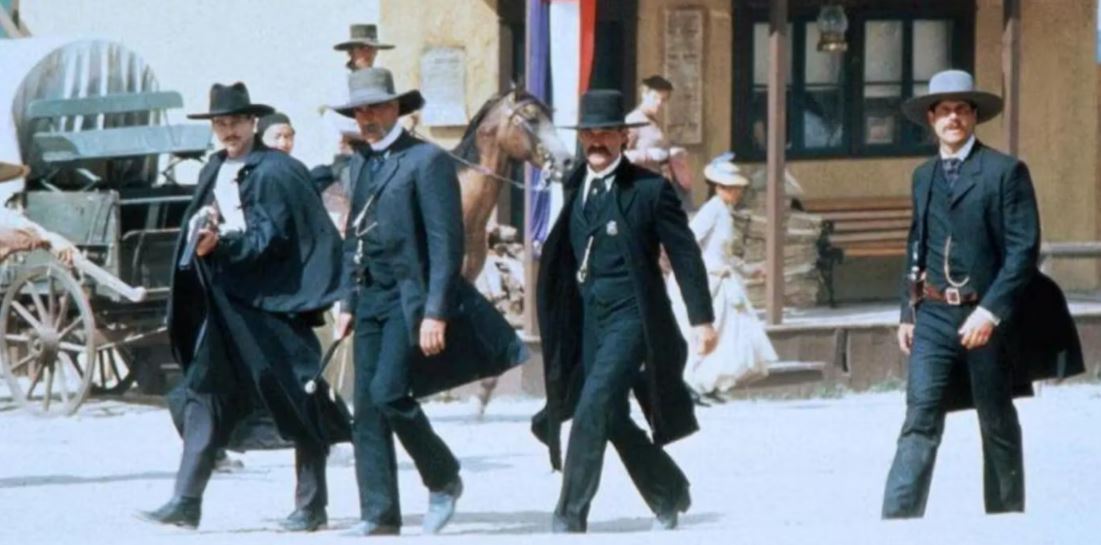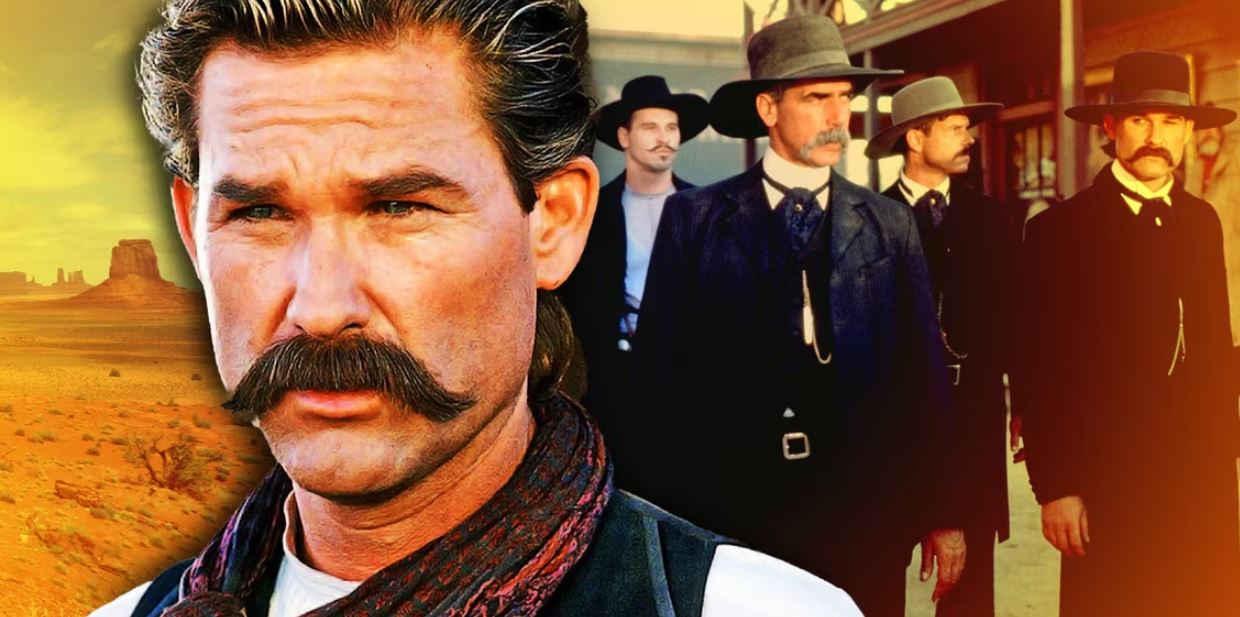There’s a line from John Ford’s highly-regarded Western The Man Who Shot Liberty Valance, starring John Wayne and Jimmy Stewart, that states, “When the legend becomes fact, print the legend,” which is what the ending of Tombstone does. Starring Kurt Russell and Val Kilmer as two icons of the American West Wyatt Earp and Doc Holliday, the ’90s classic follows Earp’s attempt at leaving gunslinging behind in Tombstone, Arizona, only to be drawn into conflict again by the Clanton Gang and quick-drawing outlaw Johnny Ringo. Tensions come to a head in one of the most famous gunfights in Wild West history; the gunfight at the O.K. Corral.
While many Westerns have immortalized the legend of Wyatt Earp and his brothers going after the Clanton clan and Johnny Ringo, few delve into what happened after the gunfight at the O.K. Corral. Tombstone’s second half is devoted to trial against the Earps for murder and the hunting party Wyatt created to avenge the deaths of Virgil and Morgan, known as The Earp Vendetta, and ends with justice being served in one blazing confrontation after the next before he departs from Tombstone along with his pal Doc Holliday. The ending changes significant amounts of history but separates Tombstone from its peers by choosing to be meaningful entertainment.
The Earp Vendetta Explained (& Why It’s So Violent)
The death of his youngest brother Morgan affects Wyatt greatly, and to accurately reflect the anger at his passing, The Earp Vendetta is portrayed as a bloodbath. Indeed, it threatens to overshadow the gunfight at the O.K. Corral, as the number of opponents stacked again Wyatt and Doc show a crusade of epic proportions. This interpretation of a vengeful, mercilessly Wyatt Earp not only makes the lawman a lot more ferocious, but it also differentiates him from the romanticized version of Earp as played by Burt Lancaster and other Westerns stars.
It took the real Wyatt Earp, Warren Earp, and Doc Holliday a little over a year to eventually round up everyone involved in Morgan’s death, and even then, some were never found. Earp, who just wanted to live out the rest of his days settled and in comfort, felt forced into a lifestyle that he sought to avoid, but with the rampant corruption in Tombstone, he knew that standing idly by would only allow men like Curly Bill Brocius (Powers Booth) and Johnny Ringo to win. The Earp Vendetta might look like it belongs in a Quentin Tarantino film, but there’s no denying its impact on the story.

What Wyatt Gives Doc In Tombstone’s Ending & What It Means
The real Doc Holliday suffered from tuberculosis for the majority of his adult life, but it didn’t stop him from becoming a feared gunslinger. Unfortunately, he’s bedridden when Wyatt visits him before facing off against Johnny Ringo, whom both men know is a faster draw than Wyatt. When Doc asks Wyatt what it’s like to wear a badge, his friend responds by giving his tin star to him. The act galvanized Doc, and he later tracks down Johnny Ringo himself, knowing that if anyone can kill him, it’s the legendary Doc Holliday.
Wyatt giving Doc his badge commemorates the numerous real occasions when Wyatt Earp deputized Doc Holliday, and it also signifies the incredible trust Wyatt had in his friend who, based on Doc’s real personality, never cared for law enforcement but loved Wyatt like a brother. In one of the film’s very final scenes, Wyatt visits Doc when he’s on his deathbed, which provides an opportunity the two men did not receive in real life, and gives him a copy of his book My Friend Doc Holliday. The scene is an example of the way creative license helps mend a moment in history that should have happened, and bring solace to two true friends.
Why The Gunfight At O.K. Corral Is So Legendary
Of the many Westerns to focus on the infamous gunfight at the O.K. Corral like “My Darling Clementine” and “Gunfight at the O.K. Corral,” Tombstone’s narrative doesn’t lead up to it as an explosive finale but rather uses the confrontation to shift tone and theme. Though it only lasted 30 seconds, it remains a legendary part of American history particularly because contrary to popular belief, conflicts of its nature were relatively rare even in the Wild West, and witnessing Wyatt, Virgil, and Morgan Earp, along with Doc Holliday stroll up the street in their black coats with steely stares would have made quite the impression.
In a matter of moments but may very well have felt like an eternity to those involved, Virgil Earp, marshal of Tombstone, led his posse to break up the Clanton Gang, who had been planning to jump Doc Holliday over a slight at the card tables the night before. To this day, no one knows who fired the first shot, but with help from Doc (using Virgil’s shotgun), the Earps managed to kill several of the cowboys that day, for which they were tried for murder. Following the gunfight with an explosive second act fueled by vengeance sets Tombstone apart from other Westerns who leave the story at the most exciting time.

Doc Holliday’s “I’m Your Huckleberry” & “Isn’t This Funny” Line Meanings & Historical Change
When Doc Holliday confronts Johnny Ringo in one final showdown, he remarks, “I’m your huckleberry,” which was common parlance for, “I’m the one you want,” and originated with men volunteering to be the pallbearer (or huckleberry) at a funeral. This stand-off never happened in real life, as Doc and Wyatt were never able to locate Ringo during the Earp Vendetta, and the outlaw took his own life some years later, but their exchange carries a certain amount of symbolism, particularly given what Latin Doc Holliday said to Johnny Ringo earlier in the film. It also conveys the length Doc would go to in order to protect Wyatt.
While Doc’s duel with Ringo might have never happened, his last line of the film was accurate. After suffering from the late stages of his illness and becoming bedridden, he would frequently experience bouts of delirium, sometimes imagining friends (like Wyatt) around him. Though Wyatt never did come to visit him in this state, Doc’s last words, “Isn’t this funny?” is accurate, as the gunsel thought he would die in a gunfight with his boots on, rather than seeing the tops of his bare toes sticking out from underneath the blanket.
What Happened To Tombstone’s Main Characters In Real Life
Tombstone changes a few of the details regarding what happened to Wyatt Earp, his surviving brothers, and Doc Holliday, but the alterations are arguably necessary for dramatic effect. The Earp brothers did stand trial for the deaths of their opponents, but the judge threw out the case, and while Wyatt set out to avenge his brother’s death, he didn’t kill as many as he did in the movie, eventually eluding arrest himself by leaving Arizona. When Morgan’s body was brought back to Colton, California, Virgil remained there to recuperate, eventually going on to become a gold prospector.
Wyatt Earp himself went on to mine for gold in the Yukon and other territories, and Doc Holliday settled in Colorado for a time, hearing of its miraculous hot springs that would only delay his early demise. Earp would eventually regale others with his tales as part of Wild West expositions, as well as provide advisement on some of the first Western films ever made. Tombstone rights a few historical wrongs along the way and embellishes a few aspects, but ultimately makes a case for the entertainment and emotional value of a revisionist western that convincingly depicts both the fact and the legend.
